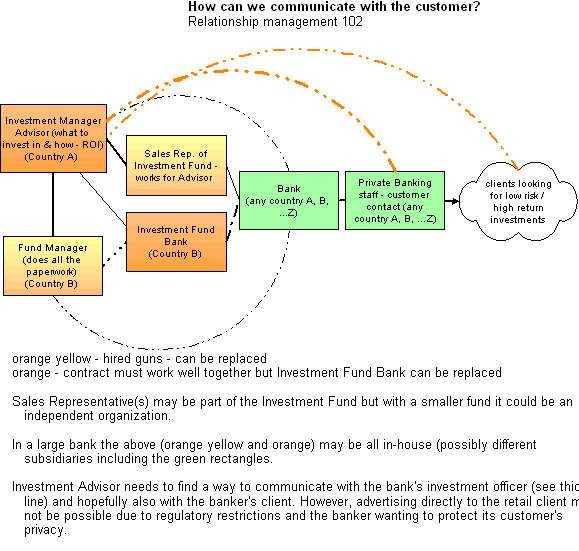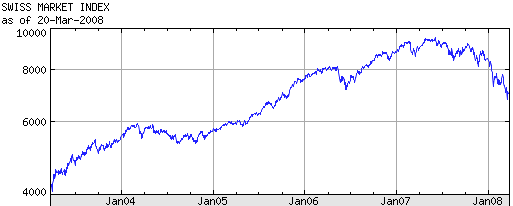London hedge fund Endeavour Capital loses 27%
David Rubenstein, co-founder of the Carlyle Group fails to save $22bn Carlyle Capital Corporation (CCC) fund
JPMorgan wanted to buy Bear Stearns for $2 a share, upped the price to $10 (remember, in Dec. 2007 the share price was over $80 and more than 30% of the stock is owned by Bear Stearns employees).
Wall Street has cut 34,000 jobs and expects the number to rise to 100,000 (Internet bubble in 2001 caused 90,000 job losses over a couple of years).
These headlines and ‘false rumours’ in the market make it ever more important to invest one’s assets wisely to avoid long-term losses
The above news was bad for sure. Publishing details of clients’ Bank LGT accounts in Italian newspapers last week was another shock. With all these negative headline’s and watchdog inquiry into City speculation in London, how is a successful investment fund supposed to communicate its successes to clients and potential investors?
Almost everybody will tell you that the key is to reach your customers as we discussed here:
– Sensible Metrics Make a Difference or Why Less Traffic is Better
The model we used was ComMetrics.com framework for measuring blogging success
The crisis at Bear Stearns triggered a series of challenges for traders and social media experts, as Wall Street tumbled towards and then edged back from an abyss.
Inefficient Markets Must be Found
The global credit squeeze made it a necessity for investment advisors to calm their client’s nerve before they took off for a long Easter weekend.
In today’s private banking and investment business large universal banks such as UBS or Deutsche Bank may provide all the services, ranging from managing the fund, selling the fund to other groups and making the investment decisions.
However, a small corporation running a small but successful fund, outsourcing may be necessary to improve operations and keep costs under control. Hence, the investment bankers may decide the fund’s strategy and investment decisions. Nevertheless, one firm may administer the fund (i.e. paper work) for the investment experts. Another, outsourcer (i.e. a bank) processes transactions on behalf of investment wizards.
What is the opportunity?
Outsourcing part of the operations enables investment officers to distribute their systematic and no so systematic risk across vehicles. If this would have to be done for each investor separately, this is far more difficult and time consuming. For instance, wanting to invest a client’s funds into more risky vehicles makes the signing of a bunch of forms necessary before the bank may even execute the trade. This all falls by the wayside when doing the same for an investment fund. Legally speaking, the fund is a ‘professional’ investor. This means investments and trades do not require much paperwork on clients’ behalf.
The problem for the investment officers is that they are far away from the customer as shown in the graphic below.

If you have trouble with the above image, get a nice one here:
How can we communicate with the customer? Relationship management 102
Who is Your Customer?
For the investment officers managing the assets on clients’ behalf it the difficulty is how they can communicate with the client. One type of client is the private banking professional who could recommend the fund certificates to the investor. Another recipient of communication through social media is the retail customer himself.
So how can social media help during a period such as last week’s seven days of shocks that unnerved investors?
How Social Media can Help
As illustrated in the chart, social media helps reaching two types of customers. These are the private banking professionals as well as their clients. One approach is to use a blog that posts relevant information for these people. Naturally, content is offered via RSS feed and/or by registering one’s e-mail address.
Since last week’s seven days of shocks that unnerved investors the latter would have wanted to know how ‘their fund’ is doing. Stock indices across Europe have been dropping since Fall 2007. In addition, as the chart below shows, the Swiss Market Index is again, where it was in Fall 2005.
Therefore, investors have gained little since Fall 2005 if not lost a bundle due to paying fees to their brokers. Here, social media allows us to inform investors how their assets are doing in a turbulent market.

If you cannot view the above chart, look here: when will the stock indices go up again?
After last week’s days of shocks, nothing calms nerves better than good news. For instance, while the market dropped amidst the US mortgage crises, your Value Fund has lost less than .10% over the last 3 months.
Social media was just the solution one of our clients needed to communicate the above news to clients and potential ones. Additionally, the fund was able to inform readers how well its clients’ portfolios were benefiting from gold hitting $1,000 amid hedge fund worries. Nothing makes one look forward more to a long Easter weekend than receiving good news mid-day Thursday.
Bottom Line
With ever more outsourcing, direct customer contact becomes ever more difficult for medium-sized firms. In the above case of an investment fund, social media provides the perfect tool to communicate with clients when the latter want to hear for sure.
While malicious rumour-mongering intended to allow one to benefit from share price movements is a crime, it is a hard crime to prove as British authorities have discovered last week. And while Bear Stearns bankers should make penance this Easter, an investor feels much better if the fund manager is able to show here a chart indicating how much her wealth has grown since Fall 2005. Very much better than the lack of positive movements as shown in the above figure by most stock indices around the globe.
Accordingly, social media offers investment fund managers a way to communicate with investment advisors and their customers. Social media provides the opportunity to communicate with clients during turbulent times.
| If this post was helpful to you, please consider stumbling this post from CyTRAP Labs | |
| Also of interest: | |
| the Mission of ComMetrics | why Benchmark |
| first steps on the way to build brand while blogging like a pro | If the web is good enough for Warren Buffett – what about you? |
PS 1. Additional benefit is that using social media correctly means one does not violate regulation that makes direct advertising of financial services illegal.
PS 2. Erroneous valuations became known in mid-February. Credit Suisse said it thought the impact would be confined to first-quarter results. However, detailed review of the issue has led it to revise its 2007 results. UK’s Financial Services Authority (FSA – the financial watchdog) has stressed that senior management in investment banks is responsible for ensuring the internal controls are adequate and lawyers expect it to take action. Credit Suisse faces FSA inquiry on mis-marking – it took the bank more than a month to spot that some of its traders had deliberately overvalued positions. Not a situation that calms investors’ nerves, is it?
Comments on this entry are closed.